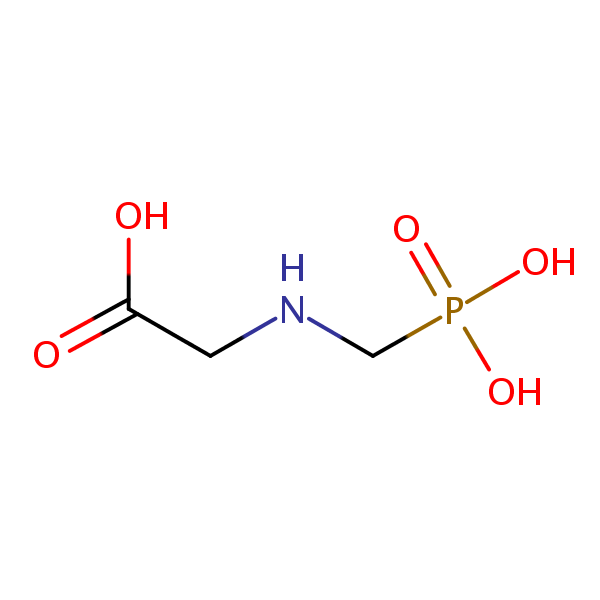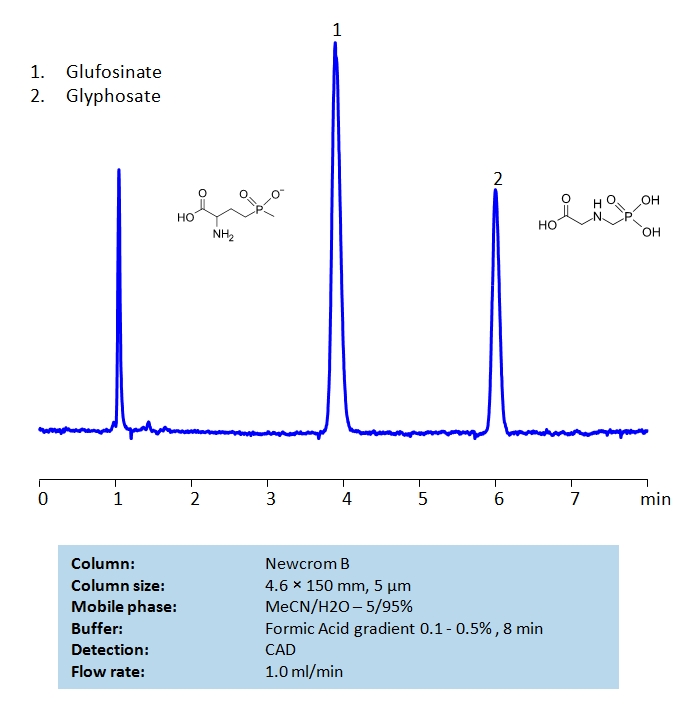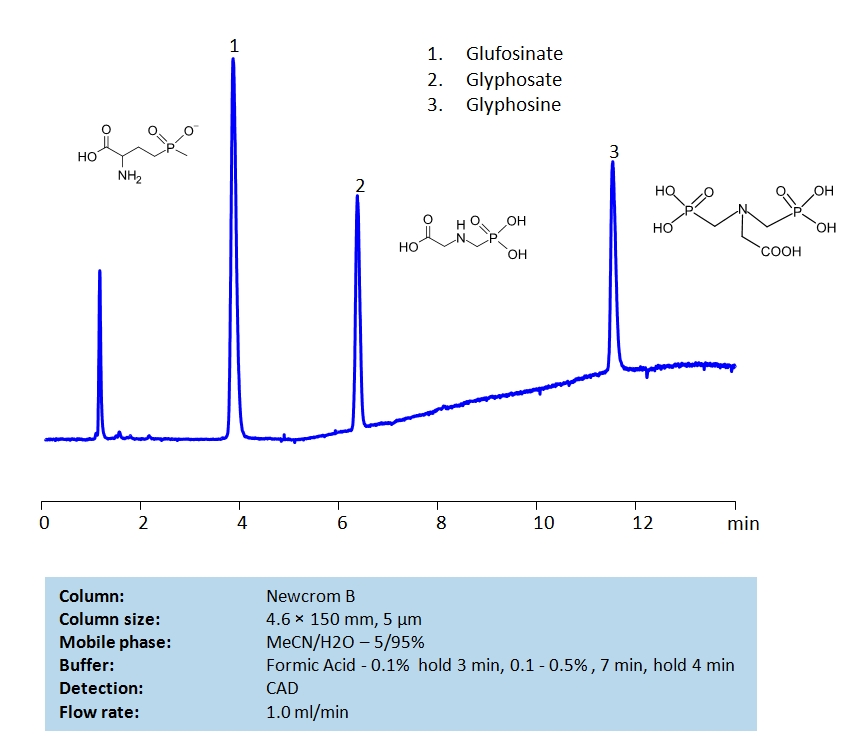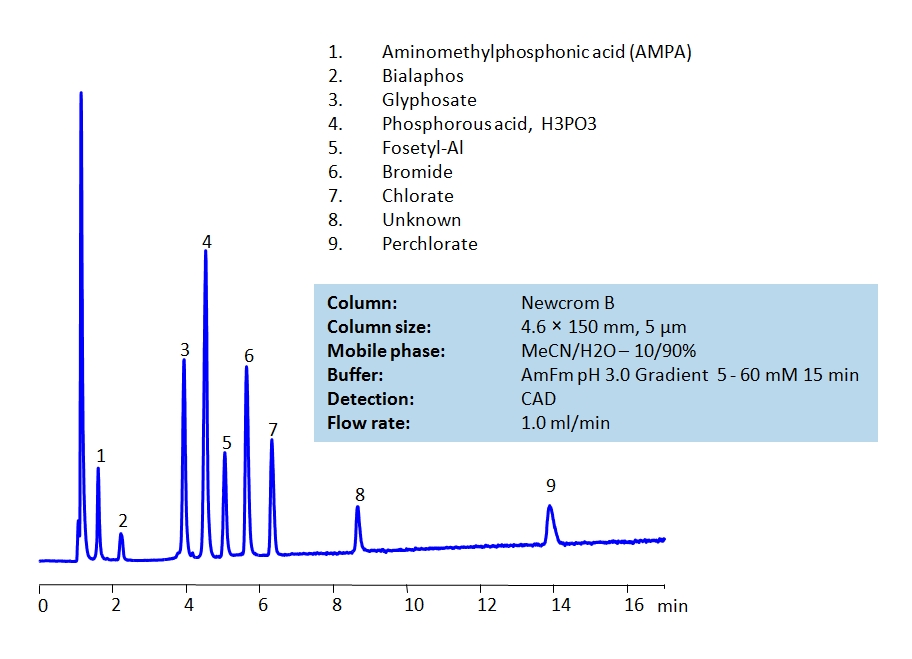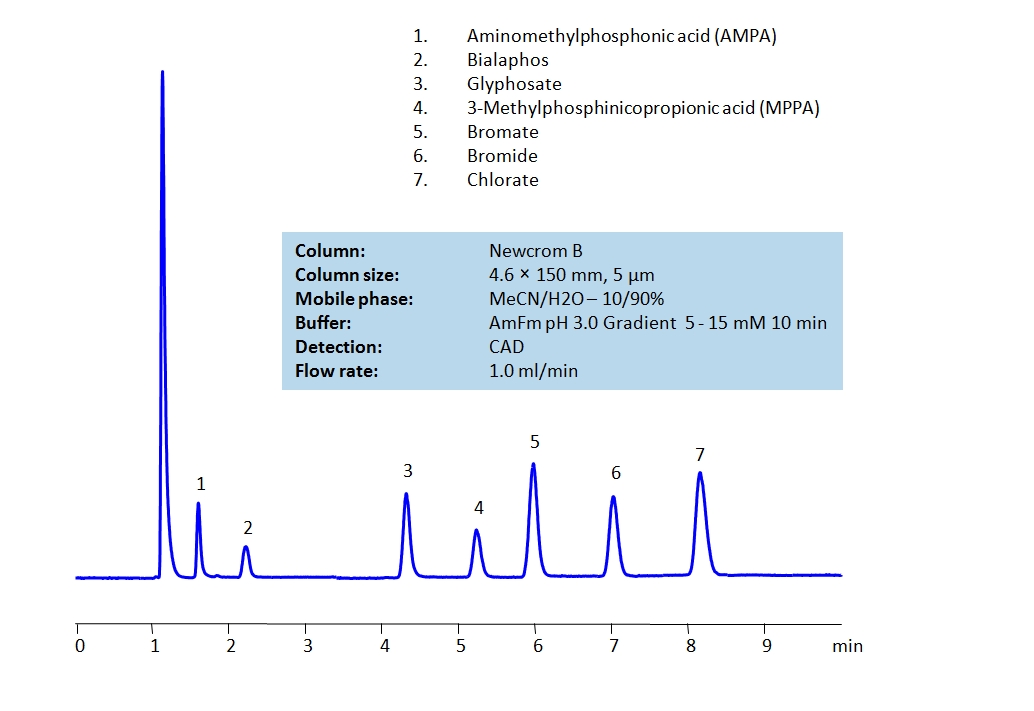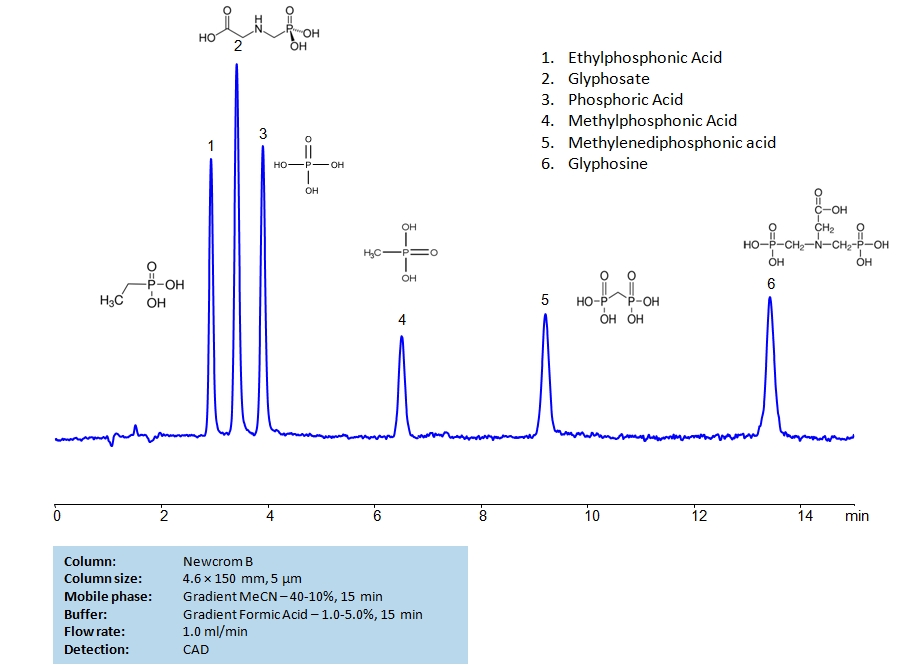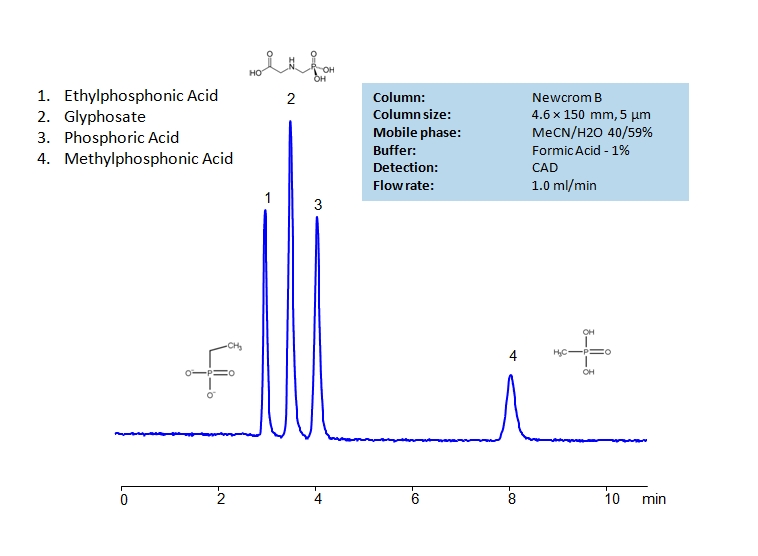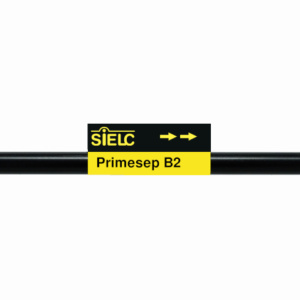| CAS Number | 1071-83-6 |
|---|---|
| Molecular Formula | C3H8NO5P |
| Molecular Weight | 169.073 |
| InChI Key | XDDAORKBJWWYJS-UHFFFAOYSA-N |
| LogP | -3.40 |
| Synonyms |
|
Applications:
HPLC Determination of Glyphosate on Newcrom B Column
March 5, 2021
Separation type: Liquid Chromatography Mixed-mode
![]()
View on hplc.cloud
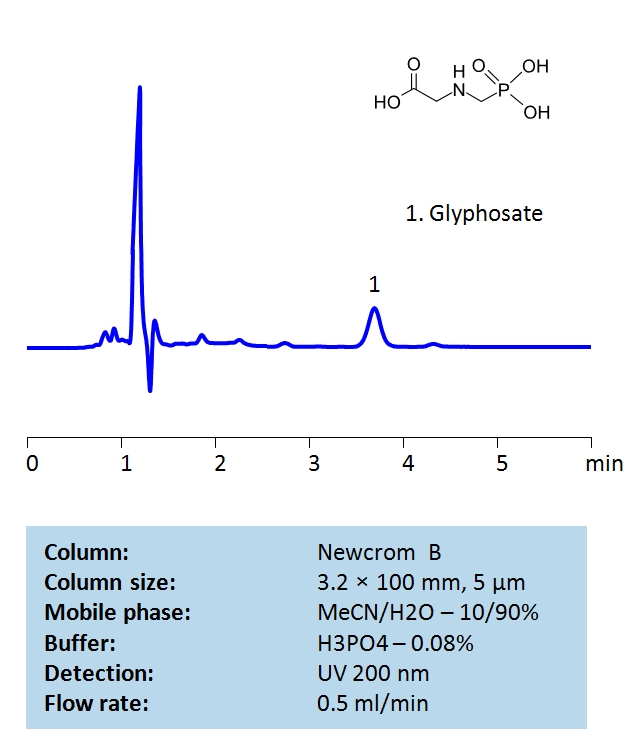
High Performance Liquid Chromatography (HPLC) Method for Analysis of Glyphosate
Glyphosate is a broad-spectrum herbicide which is used to kill weeds. Presence of glyphosate is strongly regulated by various governing agencies in the US, Europe, and Asia. Glyphosate can be retained in HPLC with a Newcrom B mixed-mode column using a mobile phase of acetonitrile (ACN, MeCN), water and phosphoric acid (H3PO4) buffer allowing the use of a UV detector at 200 nm.
| Column | Newcrom B, 3.2×100 mm, 5 µm, 100A |
| Mobile Phase | MeCN/H2O – 10/90% |
| Buffer | H3PO45 – 0.08% |
| Flow Rate | 0.5 mL/min |
| Detection | UV 200 nm |
| Class of Compounds | Hydrophobic, Herbicide, Pesticide |
| Analyzing Compounds | Glyphosate |
Application Column
Newcrom B
The Newcrom columns are a family of reverse-phase-based columns. Newcrom A, AH, B, and BH are all mixed-mode columns with either positive or negative ion-pairing groups attached to either short (25 Å) or long (100 Å) ligand chains. Newcrom R1 is a special reverse-phase column with low silanol activity.
Select options
HPLC Separation of Glufosinate, Glyphosate and Glyphosine on Newcrom B Column
December 10, 2020
| Column | Newcrom B, 4.6×150 mm, 5 µm, 100A |
| Mobile Phase | MeCN/H2O – 5/95% |
| Buffer | Formic Acid Gradient |
| Flow Rate | 1.0 ml/min |
| Detection | CAD |
| Class of Compounds | Hydrophobic, Herbicide, Pesticide |
| Analyzing Compounds | Glufosinate, Glyphosate, Glyphosine |
Application Column
Newcrom B
The Newcrom columns are a family of reverse-phase-based columns. Newcrom A, AH, B, and BH are all mixed-mode columns with either positive or negative ion-pairing groups attached to either short (25 Å) or long (100 Å) ligand chains. Newcrom R1 is a special reverse-phase column with low silanol activity.
Select optionsGlyphosate
Glyphosine

HPLC Separation of Polar Pesticides on Newcrom B Column
November 19, 2020
Pesticide is a more generic term that includes herbicides, fungicides and insecticides in its definition. Herbicides are used to control unwanted plants, they are also known as weedkillers. Insecticides are used to kill insects. Fungicides are used to kill parasitic fungi. All are heavily used in agriculture. By using HPLC, many different pesticides can be separated and their retention characteristics controlled using the Newcrom B mixed-mode column.
| Column | Newcrom B, 4.6×150 mm, 5 µm, 100A |
| Mobile Phase | MeCN/H2O – 10/90% |
| Buffer | AmFm pH 3.0 Gradient 5 – 60 mM 15 min |
| Flow Rate | 1 ml/min |
| Detection | CAD |
| Column | Newcrom B, 4.6×150 mm, 5 µm, 100A |
| Mobile Phase | MeCN/H2O – 10/90% |
| Buffer | AmFm pH 3.0 Gradient 5 – 15 mM 10 min |
| Flow Rate | 1 ml/min |
| Detection | CAD |
| Class of Compounds | Pesticides, Herbicides, Fungicides, Insecticides |
| Analyzing Compounds | Aminomethylphosphonic acid (AMPA), Bialaphos, Glyphosate, Phosphorous acid H3PO3, Fosetyl-Al, Bromide, Chlorate, Perchlorate, 3-Methylphosphinicopropionic acid (MPPA), Bromide |
Application Column
Newcrom B
The Newcrom columns are a family of reverse-phase-based columns. Newcrom A, AH, B, and BH are all mixed-mode columns with either positive or negative ion-pairing groups attached to either short (25 Å) or long (100 Å) ligand chains. Newcrom R1 is a special reverse-phase column with low silanol activity.
Select optionsAminomethylphosphonic acid (AMPA)
Bialaphos
Bromate
Bromide
Chlorate
Fosetyl-Al
Glyphosate
Perchlorate
Phosphorous acid
Sodium Bromate

HPLC Separation of Glyphosate, Glyphosine, Ethylphosphonic, Methylphosphonic, Methylenediphosphonic and Phosphoric Acids on Newcrom B Column
December 4, 2019
| Column | Newcrom B, 4.6×150 mm, 5 µm, 100A |
| Mobile Phase | MeCN Gradient -40-10%, 15 min |
| Buffer | Formic Acid Gradient -1- 5%, 15 min |
| Flow Rate | 1.0 ml/min |
| Detection | CAD |
<
| Class of Compounds | Acids, Plant growth regulator, Herbicide, Hydrophilic, Ionizable |
| Analyzing Compounds | Ethylphosphonic acid, Phosphate Ion, Methylphosphonate, Methylenediphosphonic acid, Glyphosate, Glyphosine |
Application Column
Newcrom B
The Newcrom columns are a family of reverse-phase-based columns. Newcrom A, AH, B, and BH are all mixed-mode columns with either positive or negative ion-pairing groups attached to either short (25 Å) or long (100 Å) ligand chains. Newcrom R1 is a special reverse-phase column with low silanol activity.
Select optionsGlyphosate
Glyphosine
Methylenediphosphonic acid
Methylphosphonic Acid
Phosphate
Phosphoric Acid

HPLC Separation of Glyphosate, Ethylphosphonic Acid and Methylphosphonic Acid on Newcrom B Column
December 2, 2019
| Column | Newcrom B, 4.6×150 mm, 5 µm, 100A |
| Mobile Phase | MeCN/H2O – 40/59% |
| Buffer | Formic Acid – 1% |
| Flow Rate | 1.0 ml/min |
| Detection | CAD |
| Class of Compounds | Ions, Hydrophilic, Ionizable |
| Analyzing Compounds | Ethylphosphonic acid, Phosphoric Acid, Methylphosphoric Acid, Glyphosate |
Application Column
Newcrom B
The Newcrom columns are a family of reverse-phase-based columns. Newcrom A, AH, B, and BH are all mixed-mode columns with either positive or negative ion-pairing groups attached to either short (25 Å) or long (100 Å) ligand chains. Newcrom R1 is a special reverse-phase column with low silanol activity.
Select optionsGlyphosate
Methylphosphonic Acid
Phosphate

HPLC Separation of Glyphosate and Phosphate Ion on Newcrom B Column
December 2, 2019
Separation type: Liquid Chromatography Mixed-mode
![]()
View on hplc.cloud
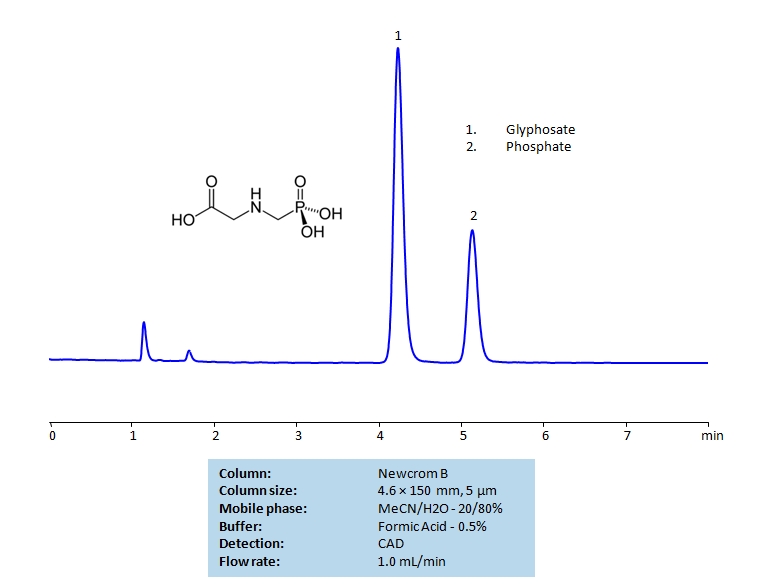
High Performance Liquid Chromatography (HPLC) Method for Analysis of Glyphosate and Phosphate Ion
Glyphosate is a broad-spectrum herbicide which is used to kill weeds. The presence of glyphosate is strongly regulated by various governing agencies in the US, Europe, and Asia. Glyphosate is characterized by its carboxylic acid and phosphate group on either end.
Glyphosate and phosphate ions can be retained and separated with a Newcrom B mixed-mode column using a mobile phase consisting of acetonitrile (MeCN), water, and formic acid (H3PO4) as a buffer. This method is compatible with mass spectrometry and be detected via a Charged aerosol detector (CAD).
| Column | Newcrom B, 4.6×150 mm, 5 µm, 100A |
| Mobile Phase | MeCN – 20% |
| Buffer | Formic Acid – 0.5% |
| Flow Rate | 1.0 ml/min |
| Detection | CAD |
| Class of Compounds |
Insecticide, Herbicide, Fungicide, Hydrophobic, Ionizable |
| Analyzing Compounds | Phosphate, Glyphosate |
Application Column
Newcrom B
The Newcrom columns are a family of reverse-phase-based columns. Newcrom A, AH, B, and BH are all mixed-mode columns with either positive or negative ion-pairing groups attached to either short (25 Å) or long (100 Å) ligand chains. Newcrom R1 is a special reverse-phase column with low silanol activity.
Select optionsPhosphate

Separation of Herbicides Paraquat, Diquat and Glyphosate in One Run with LC/MS Compatible Conditions
December 5, 2013
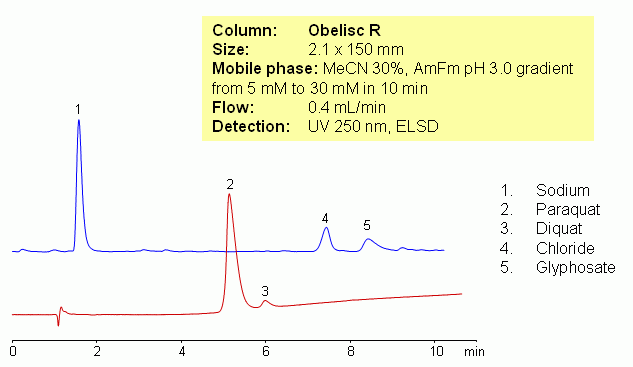
There is a need to separate different herbicides and pesticides in one run with LC/MS compatible conditions. Paraquat, diquat and glyphosate were separated on reversed-phase tri-modal cation- and anion-exchange column (Obelisc R) and on HILIC/ion-exchange columns (Obelisc N). Method explores unique properties of mixed-mode stationary phase which retains and separates cations like paraquat and diquat and anions/zwitter-ions like glyphosate in one run. Since columns are compatible with 100% organic and 100% water, a wide range of gradients can be used for analysis as well as isocratic conditions where it is desired. Method can be used for quantitation of these compounds in various matrices (soil, ground water, crops, food, etc.)
| Column | Obelisc R, 2.1×150 mm, 5 µm, 100A |
| Mobile Phase | MeCN – 30% |
| Buffer | Gradient AmFm pH 3.0 – 5-30 mM, 10 min |
| Flow Rate | 0.4 ml/min |
| Detection | UV, 250 nm, ELSD |
| Class of Compounds |
Insecticide, Herbicide, Fungicide, Hydrophobic, Ionizable |
| Analyzing Compounds | Paraquat, Diquat, Glyphosate |
Application Column
Obelisc N
SIELC has developed the Obelisc™ columns, which are mixed-mode and utilize Liquid Separation Cell technology (LiSC™). These cost-effective columns are the first of their kind to be commercially available and can replace multiple HPLC columns, including reversed-phase (RP), AQ-type reversed-phase, polar-embedded group RP columns, normal-phase, cation-exchange, anion-exchange, ion-exclusion, and HILIC (Hydrophilic Interaction Liquid Chromatography) columns. By controlling just three orthogonal method parameters - buffer concentration, buffer pH, and organic modifier concentration - users can adjust the column properties with pinpoint precision to separate complex mixtures.
Select optionsObelisc R
SIELC has developed the Obelisc™ columns, which are mixed-mode and utilize Liquid Separation Cell technology (LiSC™). These cost-effective columns are the first of their kind to be commercially available and can replace multiple HPLC columns, including reversed-phase (RP), AQ-type reversed-phase, polar-embedded group RP columns, normal-phase, cation-exchange, anion-exchange, ion-exclusion, and HILIC (Hydrophilic Interaction Liquid Chromatography) columns. By controlling just three orthogonal method parameters - buffer concentration, buffer pH, and organic modifier concentration - users can adjust the column properties with pinpoint precision to separate complex mixtures.
Select optionsGlyphosate
Paraquat
UV Detection

Separation of Paraquat, Diguat, and Glyphosate on Obelisc R Column
July 3, 2013
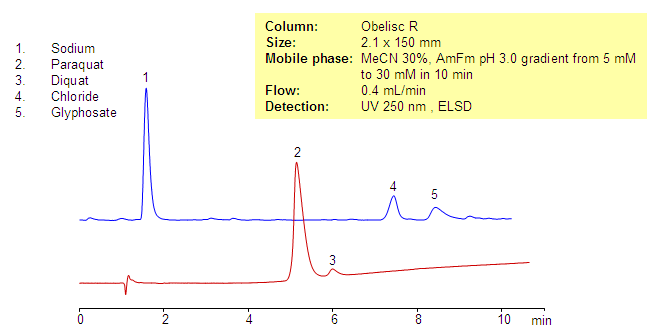
Paraquat, diquat and glyphosate are three of most widely used herbicides in the world. Paraquat and diquat are very polar and very basic quaternary amines. Glyphosate is an aminophosphonic analog of glycine. It is very polar and acidic at most of the pH of the mobile phase. Since glyphosate and the quats have opposite charges no ion-pairing method can be developed for the mixture of basic and acidic herbicides. All three herbicides were separated on the Obelisc R tri-modal column. Paraquat and diquat are retained by a cation-exchange mechanism, and glyphosate is retained by weak reversed-phase and strong anion-exchange mechanisms. This method can be used for analysis of common herbicides in fruits, vegetables, ground water, drinking water and other matrices. Method is LC/MS compatible and can be used to determine trace levels of herbicides.
| Column | Obelisc R, 2.1×150 mm, 5 µm, 100A |
| Mobile Phase | MeCN – 30% |
| Buffer | Gradient AmFm pH 3.0 – 5-30 mM, 10 min |
| Flow Rate | 0.4 ml/min |
| Detection | UV, 250 nm, ELSD |
| Class of Compounds |
Insecticide, Herbicide, Fungicide, Hydrophobic, Ionizable |
| Analyzing Compounds | Paraquat, Diquat, Glyphosate |
Application Column
Obelisc R
SIELC has developed the Obelisc™ columns, which are mixed-mode and utilize Liquid Separation Cell technology (LiSC™). These cost-effective columns are the first of their kind to be commercially available and can replace multiple HPLC columns, including reversed-phase (RP), AQ-type reversed-phase, polar-embedded group RP columns, normal-phase, cation-exchange, anion-exchange, ion-exclusion, and HILIC (Hydrophilic Interaction Liquid Chromatography) columns. By controlling just three orthogonal method parameters - buffer concentration, buffer pH, and organic modifier concentration - users can adjust the column properties with pinpoint precision to separate complex mixtures.
Select optionsDiquat
Glyphosate
Paraquat
Sodium
UV Detection

Method for Analysis of Glyphosate in Apple Juice, Cranberry Juice, Mango Juice and Green Tea
July 3, 2013
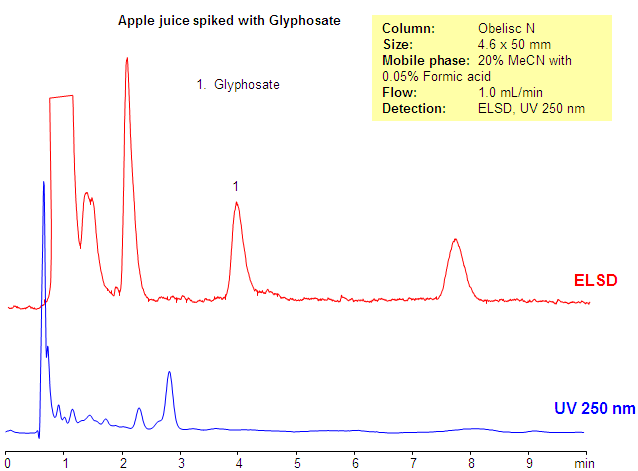
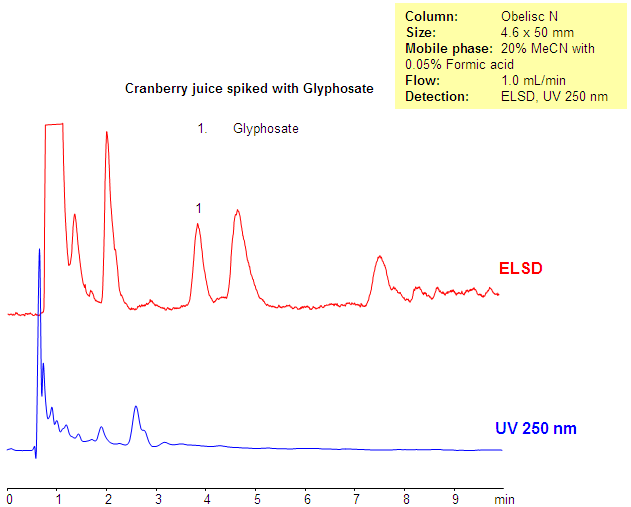
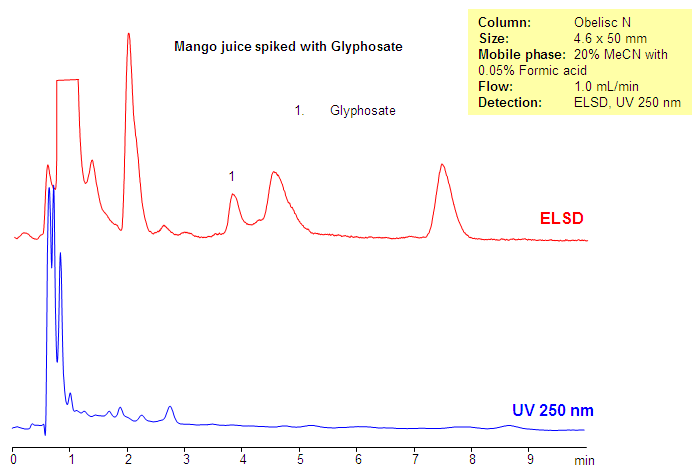
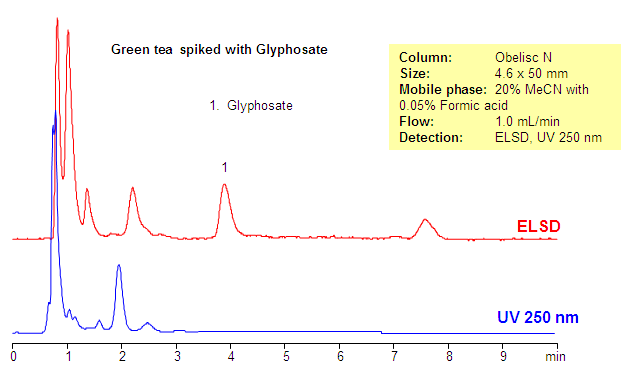
Glyphosate is a broad-spectrum herbicide which is used to kill weeds. Presence of glyphosate is strongly regulated by various governing agencies in the US, Europe, and Asia. Method for analysis of glyphosate in fruit juices and teas was developed using the Obelisc N HILIC/ion-exchange column. Glyphosate is retained by an ion-exchange mechanism. Since the method uses a highly aqueous mobile phase, which is not usual, for HILIC columns, none of the sugars, vitamins and other components of juices interfere with the analysis of glyphosate. Samples of juices were spiked with glyphosate. This method can be used in combination with LC/MS for determination of very low concentrations of glyphosate in various fruits and vegetables as well as ground and drinking water.
| Column | Obelisc N, 4.6×50 mm, 5 µm, 100A |
| Mobile Phase | MeCN/H2O – 20/80% |
| Buffer | Formic acid – 0.05% |
| Flow Rate | 1.0 ml/min |
| Detection | UV, 250 nm, ELSD |
| Class of Compounds |
Herbicide, Hydrophilic, Ionizable |
| Analyzing Compounds | Glyphosate |
Application Column
Obelisc N
SIELC has developed the Obelisc™ columns, which are mixed-mode and utilize Liquid Separation Cell technology (LiSC™). These cost-effective columns are the first of their kind to be commercially available and can replace multiple HPLC columns, including reversed-phase (RP), AQ-type reversed-phase, polar-embedded group RP columns, normal-phase, cation-exchange, anion-exchange, ion-exclusion, and HILIC (Hydrophilic Interaction Liquid Chromatography) columns. By controlling just three orthogonal method parameters - buffer concentration, buffer pH, and organic modifier concentration - users can adjust the column properties with pinpoint precision to separate complex mixtures.
Select optionsUV Detection

Method for Analysis of Glyphosate in Cranberry Juice
July 3, 2013

| Column | Obelisc N, 4.6×50 mm, 5 µm, 100A |
| Mobile Phase | MeCN/H2O – 20/80% |
| Buffer | Formic acid – 0.05% |
| Flow Rate | 1.0 ml/min |
| Detection | UV, 250 nm, ELSD |
| Class of Compounds |
Herbicide, Hydrophilic, Ionizable |
| Analyzing Compounds | Glyphosate |
Application Column
Obelisc N
SIELC has developed the Obelisc™ columns, which are mixed-mode and utilize Liquid Separation Cell technology (LiSC™). These cost-effective columns are the first of their kind to be commercially available and can replace multiple HPLC columns, including reversed-phase (RP), AQ-type reversed-phase, polar-embedded group RP columns, normal-phase, cation-exchange, anion-exchange, ion-exclusion, and HILIC (Hydrophilic Interaction Liquid Chromatography) columns. By controlling just three orthogonal method parameters - buffer concentration, buffer pH, and organic modifier concentration - users can adjust the column properties with pinpoint precision to separate complex mixtures.
Select optionsUV Detection

Method for Analysis of Glyphosate in Mango Juice
July 3, 2013

UV Detection

Method for Analysis of Glyphosate in Green Tea
July 3, 2013

| Column | Obelisc N, 4.6×50 mm, 5 µm, 100A |
| Mobile Phase | MeCN/H2O – 20/80% |
| Buffer | Formic acid – 0.05% |
| Flow Rate | 1.0 ml/min |
| Detection | UV, 250 nm, ELSD |
| Class of Compounds |
Herbicide, Hydrophilic, Ionizable |
| Analyzing Compounds | Glyphosate |
Application Column
Obelisc N
SIELC has developed the Obelisc™ columns, which are mixed-mode and utilize Liquid Separation Cell technology (LiSC™). These cost-effective columns are the first of their kind to be commercially available and can replace multiple HPLC columns, including reversed-phase (RP), AQ-type reversed-phase, polar-embedded group RP columns, normal-phase, cation-exchange, anion-exchange, ion-exclusion, and HILIC (Hydrophilic Interaction Liquid Chromatography) columns. By controlling just three orthogonal method parameters - buffer concentration, buffer pH, and organic modifier concentration - users can adjust the column properties with pinpoint precision to separate complex mixtures.
Select optionsUV Detection

Effect of pH on Separation of Glyphosate and Ethylphosphonic Acid
July 8, 2011
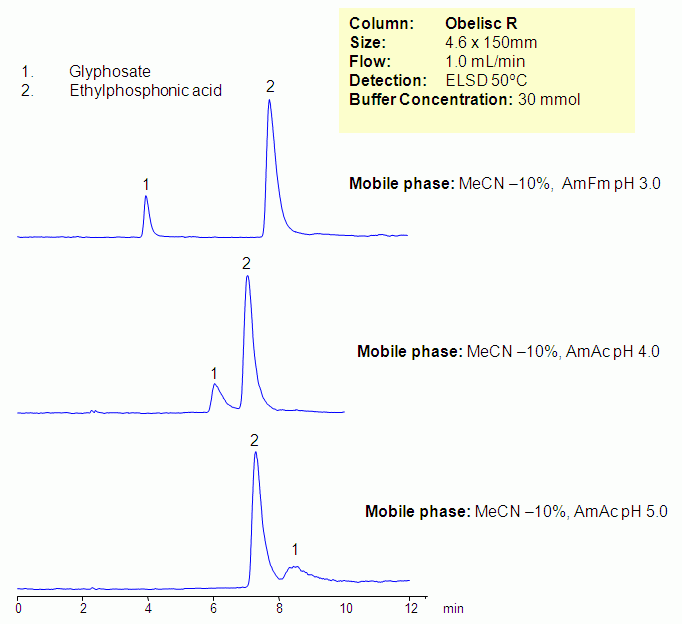
Glyphosate is broad spectrum herbicide to kill weeds. Presence of glyphosate in water, fruits and veggies is regulated. Alkylphosphonic acids are decomposition byproducts of chemical warfare agents. Analysis of phosphonic acid in water is regulated by Environmental Protection Agency (EPA). All phosphonic acids are polar acidic compounds. Method was developed for glyphosate and ethylphosphonic acid. Both compounds are retained by ion-exchange mechanism. Method is compatible with LC/MS and can be used for analysis of glyphosate and alkylphosphonic acids in various matrices.
| Column | Obelisc R, 4.6×150 mm, 5 µm, 100A |
| Mobile Phase | MeCN – 10% |
| Buffer | AmAc |
| Flow Rate | 1.0 ml/min |
| Detection | ELSD 50C |
<
| Class of Compounds |
Insecticide, Herbicide, Fungicide, Hydrophobic, Ionizable |
| Analyzing Compounds | Glyphosate, Ethylphosphonic acid |
Application Column
Obelisc R
SIELC has developed the Obelisc™ columns, which are mixed-mode and utilize Liquid Separation Cell technology (LiSC™). These cost-effective columns are the first of their kind to be commercially available and can replace multiple HPLC columns, including reversed-phase (RP), AQ-type reversed-phase, polar-embedded group RP columns, normal-phase, cation-exchange, anion-exchange, ion-exclusion, and HILIC (Hydrophilic Interaction Liquid Chromatography) columns. By controlling just three orthogonal method parameters - buffer concentration, buffer pH, and organic modifier concentration - users can adjust the column properties with pinpoint precision to separate complex mixtures.
Select optionsGlyphosate

HPLC Separation of Glyphosate Reaction Intermediates and Impurities
March 3, 2010

Glyphosate and intermediates/impurities of production are separated on an Obelisc N HILIC/ion-exchange column by a combination of HILIC and ion-exchange mechanism. Method can be used in analysis of glyphosate, iminodiacetic acid, (N-phosphonomethyl)-imminodiacetic acid, diethanolamine and related impurities in reaction mixtures, waste and ground waters. Detection techniques are LC/MS, ELSD, CAD and UV.
| Column | Obelisc N, 4.6×150 mm, 5 µm, 100A |
| Mobile Phase | MeCN/H2O |
| Buffer | Ammonium Formate |
| Flow Rate | 1.0 ml/min |
| Detection | ELSD |
| Class of Compounds |
Herbicide, Hydrophilic, Ionizable |
| Analyzing Compounds | Glyphosate, IDA, PMIDA, DEA |
Application Column
Obelisc N
SIELC has developed the Obelisc™ columns, which are mixed-mode and utilize Liquid Separation Cell technology (LiSC™). These cost-effective columns are the first of their kind to be commercially available and can replace multiple HPLC columns, including reversed-phase (RP), AQ-type reversed-phase, polar-embedded group RP columns, normal-phase, cation-exchange, anion-exchange, ion-exclusion, and HILIC (Hydrophilic Interaction Liquid Chromatography) columns. By controlling just three orthogonal method parameters - buffer concentration, buffer pH, and organic modifier concentration - users can adjust the column properties with pinpoint precision to separate complex mixtures.
Select optionsGlyphosate
IDA (Iminodiacetic acid)
PMIDA (Phosphonomethyliminodiacetic acid)

HPLC Separation of Glyphosate Production Intermediates
January 13, 2010
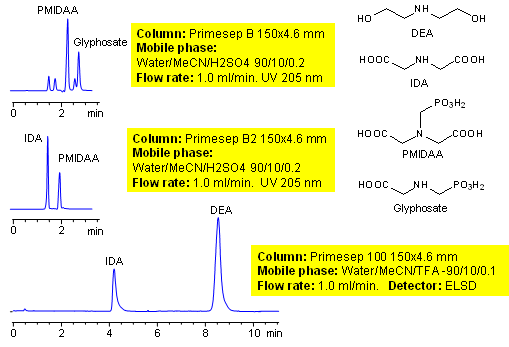
Glyphosate is a broad spectrum herbicide used to kill weeds. It is the most used herbicide. Glyphosate is an aminophosphonic analogue of the natural amino acid glycine. Glyphosate and its intermediates are very polar ionic compounds derived from glycine. Neither of intermediates can be retained on traditional reversed-phase columns. Two methods for glyphosate intermediates were developed on Primesep B, Primesep B2 and Primesep 100 columns.
| Column | Primesep B, Primesep B2, Primesep 100, 4.6×150 mm, 5 µm, 100A |
| Mobile Phase | MeCN/H2O |
| Buffer | TFA, H2SO4 |
| Flow Rate | 1.0 ml/min |
| Detection | ELSD |
| Class of Compounds |
Insecticide, Herbicide, Fungicide, Hydrophobic, Ionizable |
| Analyzing Compounds | Glyphosate, PMIDAA, IDA |
Application Column
Primesep 100
The Primesep family of mixed-mode columns offers a wide variety of stationary phases, boasting unprecedented selectivity in the separation of a broad array of chemical compounds across multiple applications. Corresponding Primesep guard columns, available with all stationary phases, do not require holders. SIELC provides a method development service available to all customers. Inquire about our specially-tailored custom LC-phases for specific separations.
Select optionsPrimesep B
The Primesep family of mixed-mode columns offers a wide variety of stationary phases, boasting unprecedented selectivity in the separation of a broad array of chemical compounds across multiple applications. Corresponding Primesep guard columns, available with all stationary phases, do not require holders. SIELC provides a method development service available to all customers. Inquire about our specially-tailored custom LC-phases for specific separations.
Select optionsPrimesep B2
The Primesep family of mixed-mode columns offers a wide variety of stationary phases, boasting unprecedented selectivity in the separation of a broad array of chemical compounds across multiple applications. Corresponding Primesep guard columns, available with all stationary phases, do not require holders. SIELC provides a method development service available to all customers. Inquire about our specially-tailored custom LC-phases for specific separations.
Select optionsDiethanolamine
Glyphosate
IDA (Iminodiacetic acid)
Iminodiacetic Acid
PMIDA (Phosphonomethyliminodiacetic acid)
Phosphonomethyliminodiacetic Acid
UV Detection

HPLC Separation of Isopropylamine and Glyphosate
December 6, 2007
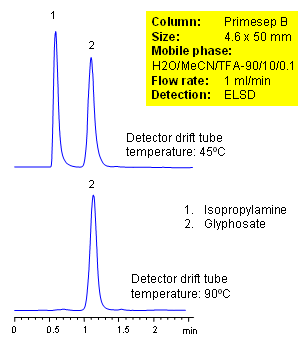
| Column | Primesep B, 4.6×50 mm, 5 µm, 100A |
| Mobile Phase | MeCN/H2O |
| Buffer | TFA |
| Flow Rate | 1.0 ml/min |
| Detection | ELSD |
| Class of Compounds |
Insecticide, Herbicide, Fungicide, Hydrophobic, Ionizable |
| Analyzing Compounds | Glyphosate, Isppropylamine |
Application Column
Primesep B
The Primesep family of mixed-mode columns offers a wide variety of stationary phases, boasting unprecedented selectivity in the separation of a broad array of chemical compounds across multiple applications. Corresponding Primesep guard columns, available with all stationary phases, do not require holders. SIELC provides a method development service available to all customers. Inquire about our specially-tailored custom LC-phases for specific separations.
Select optionsIsopropylamine

Separation of Glyphosate by Cation Exchange and Anion Exchange
July 6, 2003
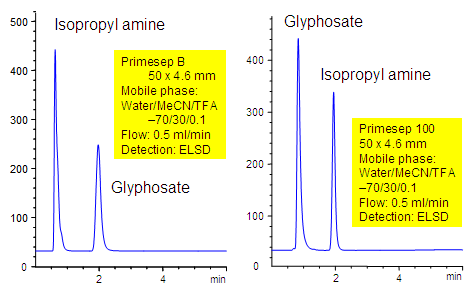
Primesep 100 separates a mixture of glyphosate and isopropylamine by HPLC using cation exchange as a retention mechanism. The peak order of this mixture is reversed on a Primesep B column which uses anion exchange. This combination offers an alternative to ion chromatography for the simultaneous analysis of complex herbicide mixtures. Glyphosate, other phosphonomethyl herbicides, and their amine salts can be analyzed with a mobile phase mixture of water, acetonitrile (MeCN, ACN) and trifluoroacetic acid (TFA) and evaporative light scattering detection (ELSD).
| Column | Primesep B, Primesep 100, 4.6×50 mm, 5 µm, 100A |
| Mobile Phase | MeCN/H2O |
| Buffer | TFA |
| Flow Rate | 0.5 ml/min |
| Detection | ELSD |
| Class of Compounds |
Insecticide, Herbicide, Fungicide, Hydrophobic, Ionizable |
| Analyzing Compounds | Glyphosate, Isppropylamine |
Application Column
Primesep 100
The Primesep family of mixed-mode columns offers a wide variety of stationary phases, boasting unprecedented selectivity in the separation of a broad array of chemical compounds across multiple applications. Corresponding Primesep guard columns, available with all stationary phases, do not require holders. SIELC provides a method development service available to all customers. Inquire about our specially-tailored custom LC-phases for specific separations.
Select optionsPrimesep B
The Primesep family of mixed-mode columns offers a wide variety of stationary phases, boasting unprecedented selectivity in the separation of a broad array of chemical compounds across multiple applications. Corresponding Primesep guard columns, available with all stationary phases, do not require holders. SIELC provides a method development service available to all customers. Inquire about our specially-tailored custom LC-phases for specific separations.
Select optionsIsopropylamine

